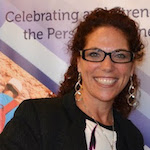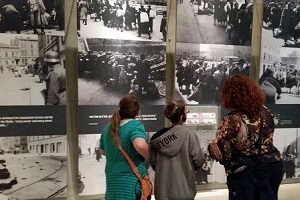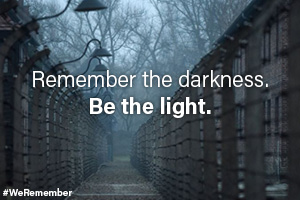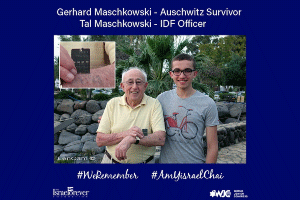Memory of Sighet: A Place Called Home
For hundreds of years, small towns scattered the landscape of Eastern Europe, stretching from East to West, North to South, filled with the teeming life of Jews and their daily routines, their seasonal holiday celebrations, their ongoing learning, and the endless transmission of tradition, identity, and memory. This all changed with the Holocaust.
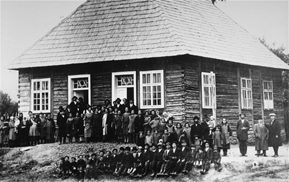
The Jewish community of Sighet in front of the main synagogue 1930s
Among the countries and communities decimated by the Holocaust, Sighet, Romania, is perhaps but a random, insignificant example of what transpired under the Nazi regime and at the hands of its collaborators. Situated along the Tisa river on the border with Ukraine, Sighet is known to most as the birthplace of Elie Wiesel.
His legacy as Holocaust survivor, educator, author, activist, Nobel Peace Prize recipient and, as an extension of his memory, Sighet, have been secured in Wiesel’s speeches, his books, and the lessons that he has passed on to the world. His nostalgic love for his childhood home can be found throughout his memory work and literary expression, wherein his words, actions, and vision, the memory of Jewish Sighet is perpetuated, transforming this small town into a place of memory for others to glean from for generations to come.
A PLACE CALLED HOME
At 15 years old, like countless other Jews, Elie Wiesel endured the severity of ghetto reality, was forced from his childhood home, onto a cattle car, and put through selection at Birkenau. He lost his mother and baby sister who were sent to the gas upon arrival and, later, witnessed the death of his father in front of his eyes. In Birkenau and Buna, he experienced the daily torture of life under the Nazis in what he termed “the kingdom of hell” He endured a death march and several months in Buchenwald before, unlike most others, transforming his miraculous survival into a life-long pursuit of justice, human rights, dignity for the persecuted, and, above all, the memory of the Holocaust and of a Jewish world since destroyed.
As with many survivors, memories of their childhood encompass both positive and painful experiences connected to their place of birth and the life enjoyed there. Their joyful existence before the onset of the Holocaust is infused with the endearing, heartfelt warmth of home, community, tradition, and the dreams of their youth. The place lives on in their recollections of family, friends, and experiences before they were shattered by the onset of terror, persecution, and the momentary survival of life in the ghettos and camps.
As Wiesel recounts in his memoirs,
“Why is it that my town still enchants me so? Is it because in my memory it is entangled with my childhood? In all my novels it serves as background and vantage point. In my fantasy I still see myself in it… Even when I tell Biblical, Talmudic, or Hasidic tales, it is from my town that they take flight.
It is in the gardens of Sighet that the sages compose the Talmud, in the flickering lights of its candles that they weave legends for the Midrash, along its rivers that exiles hang their harps and week when they remember Zion. It is in the darkness of its forests that Rabbi Isaac Lurie and his disciples dream of ultimate redemption. That’s how it is and there is nothing I can do about it. I left Sighet, but it refuses to leave me.” (All Rivers Run to the Sea, p 31–2)
Wiesel conjured up images of the life in Sighet again and again through his writing over the years, continuously seeking closure with this place that was such an important part of his personal memory. Long after the destruction of the community life he so cherished, he sought out the secrets of the place and its inhabitants, both the Jews and the Gentiles, in an effort to understand their behavior when faced with the forces of evil that allowed for silence in the face of the murder of a whole people.
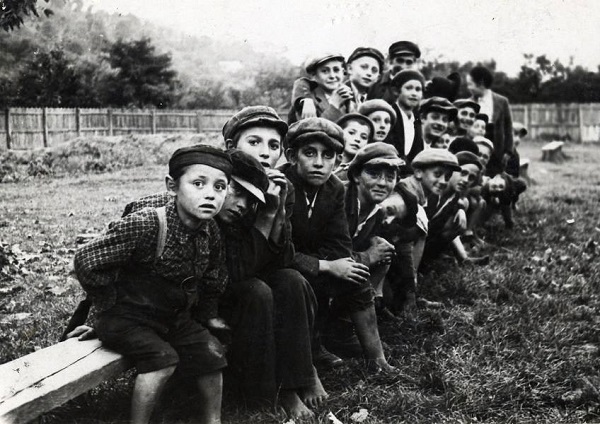
Students of Jewish traditional Kheyder, Sighet 1920s
In the years of his absence, between the suffering, the sorrow, and the solitude that remained in his life after his survival, Sighet continued to reverberate in Wiesel’s mind, calling him back, yet simultaneously pushing him away – perhaps out of fear of what he might find there.
“For years I dreamed of returning to my native town. It was an obsession. It took two decades, and that trip has now been added to my obsessions. It was night. There was a sleeping town and a sleeping house which hadn’t changed; the same gate, same garden, same well.” (All Rivers Run to the Sea, p 72)
Despite mixed feelings, he sees a town unchanged since his deportation to Nazi concentration camps in 1944, except for one significant feature: the absence of his Jewish brethren that had been an instrumental, dynamic aspect of Sighet life.
“I found it hard to orient myself in the little town. It seems not to have endured a war. The streets were teeming with people. The park was as it had been, the trees and benches still in place. Everything was there. As before. Everything except the Jews. (All Rivers Run to the Sea, p. 372)
Whereas today there are but around 80 Jews in the town, the oldest being a 104-year-old woman who survived the Holocaust because the gas chamber mechanism did not work, the obvious void makes it difficult to reconcile the past and the present.
“I see it with the eyes of a child, a small Jewish town with its synagogues and workshops, princes and beggars, porters and clients. All that is now gone. The Jews of my city are now forgotten, erased from its memory. Before, there were some thirty synagogues in Sighet; today, only one survives. The Jewish tailors, the Jewish cobblers, the Jewish watchmakers have vanished without a trace, and strangers have taken their place. In the space of six weeks, a vibrant and creative community had been condemned first to isolation, then to misery, and finally to deportation and death.[1]"
The streets have since been repaved, just as the memory of the ghetto, the selections, the deportation of the Jews have been covered by decades of life continuing, buildings renovated and modernized, gardens and parks blooming with color.
“Sighet my hometown, a special place, an inhabited setting that haunts my memory. I return to it often in my imagination. A search for landmarks? Perhaps for certainties? The permanent obsession nourishes my writing… If, in my books, I return so often to my childhood, my purpose is to describe its death. I return to Sighet to confirm the disappearance of its Jews, myself included. Yes, Sighet no longer exists except in the memory of those it expelled.[2]”
It is the brief description in Wiesel’s Night that describes what transpired in Sighet during the war, as is his denunciation of the bystanders who witnessed the loading of cattle cars and made no outcry. The slumber of this small town was awakened by the march of war when, between May 17–21, 1944, nearly 14,000 Jews, who had made up over 30% of the town’s population at the time, were rounded up in the town square and marched through the deserted streets to the local railway station, forced into cattle cars for a 3-day journey to an unknown destination.
Perhaps the details of the destruction of the Jews of Sighet bear little uniqueness from the stories of other towns, but this place has since gained recognition as a part of the legacy of a man who has impacted the world in so many ways. It was Wiesel’s dream to create an event to memorialize the deportation of the Jews of Sighet, to protect the history and the human experience in a powerful, meaningful way. Years later, his vision helped transform Sighet into a place of memory.
RETURNING TO REMEMBER
Wiesel once stated, “I was driven from Sighet, but my roots are still there. The farther away I go, the deeper I sink into Sighet.[3]” In his memoirs, he recalled,
“Before me, always, is the photograph of the house in which I was born. The door that leads to the yard. The kitchen… I want to go inside, but I am afraid. I want to look at the house, if only from afar. With all that has happened to me, it is essential for me to remember that place.” (And the Sea is Never Full, p. 4)

Under the banner of “Antisemitism Led to Auschwitz,” a memorial event in 2017 translated an abstract, somewhat mystified experience of the historical march of death into a march of life, a march of memory in the present when a communal torchlight procession of local non-Jews, dignitaries from Romania, Hungary, Israel and the United States, and friends of Wiesel and myself - the only student of Elie’s in attendance - made its way through the city.
Beginning at the childhood home of Wiesel and following the very path where the Wiesel family and the other Jews of Sighet were forced to march from the ghetto toward the deportation trains that would take them to an unknown destination: Auschwitz-Birkenau - a march against the hatred and indifference that enabled the destruction of the Holocaust, and a march of commitment to the legacy of Elie Wiesel.
While physical reminders of the catastrophe were virtually absent, for those who knew the tragic details of what transpired there, echoes of the past were embedded in their minds – the abandoned Jewish homes, the sound of mothers and babies crying in the streets on their procession toward the trains, the barking of the Nazi dogs, and the pervasive silence of the bystanders that Wiesel recounted in Night when he wrote, “From behind their windows, from behind their shutters, our fellow citizens watched as we passed.” (p. 19)
The march participants arrived at the train station united in their quest, not just to honor Elie Wiesel, but to remember all the citizens of Sighet who were driven from their homes and ultimately led to their murder.
“Can you hear it?” asked Greg Schneider, Executive Vice President of the Claims Conference, of the marchers. “If you close your eyes and you’re very quiet, you can hear the whispers, the soft muted whispers of the thousands of people who were in this very place. Each one with a dream, with a hope, an aspiration for their own lives. But for me, my struggle is that the soft whisper is drowned out by the loud screaming of despair, of pain, hunger and beatings; a torture which is incomprehensible to all of us.
This march, however, was a march of triumph, or, as Social Equality Minister for Israel Gila Gamliel proclaimed, “This is our never again.”
BECOMING A WITNESS: A MARCH OF MEMORY
At the ceremony on the threshold of the train station, Sighet Mayor Horia Vasile Scubli proclaimed, “We are the city of Elie Wiesel, and it is necessary to keep his memory alive.” It was important to Wiesel that local residents would hear the stories, see with their eyes the power of memory, and feel the loss that transpired in their town.
Asserting the uniqueness of the Holocaust by way of the creation of local memorials, including Wiesel’s childhood home, was aimed to counter the relative public silence about the specificity of the Nazi genocide of the Jews, as well as the complicity of the local community at that time. In doing so, the combined effect would hopefully foster understanding of the history in a personal way that would generate recognition, acknowledgment, and continued study of its horrific particularities and traumas and their impact on the future.
Wiesel’s private memory has become the collective memory of an entire people. What that collective inheritance of memory means for the future is best determined by the impact of the experience on the next generation - the youth who joined the march as the protectors of the memory that Sighet can be for the future – Wiesel’s childhood home, the Holocaust memorial square, the Holocaust Cellar center of learning, and, now, the train station that was renamed “Gare Elie Wiesel”.
The real estimation of the success of the transmission of memory is the impact on the locals. Romanian Holocaust education continues to expand, and more young minds are being informed about the dangers of hate and extremism, the emphasis on the trends of modern Antisemitism are crucial to the learning experience. This place will forever bear the mark of not only the stark reality of what transpired during the Holocaust, but also that of the legacy of one man who helped many understand the significance of one little town.
Unfortunately, we still find ourselves having to deal with the hatred of Holocaust deniers and their supporters, the constant manifestation of Antisemitism and the dangers caused by the ignorance of many. Therefore, it is our duty to continue this struggle waged by Elie Wiesel against hatred, fanaticism, and demons of the past״
Indeed, every town where there was once a thriving Jewish community has the potential to become a place of memory, but many, perhaps most, have been lost to the annals of history, having disappeared into the reminiscences of former inhabitants and few Jews that returned. As we move farther away from the vibrant life that once thrived in Eastern Europe, and the number of Jews in these communities and survivors worldwide dwindles, what role do these old Jewish towns carry as places of memory?
While Jews from around the world continue to explore their roots and heritage through journeys to these forgotten landscapes, to what extent are these small remnants a part of the inheritance we carry in our perpetual memory of the Holocaust? Were it not for the significance of Elie Wiesel – in the world as well as the Romanian communal identity – would Sighet be any different from any other town whose evidence of Jewish life is perpetuated through its one remaining synagogue, its few remaining Jews, its cemetery and few un-shattered gravestones?
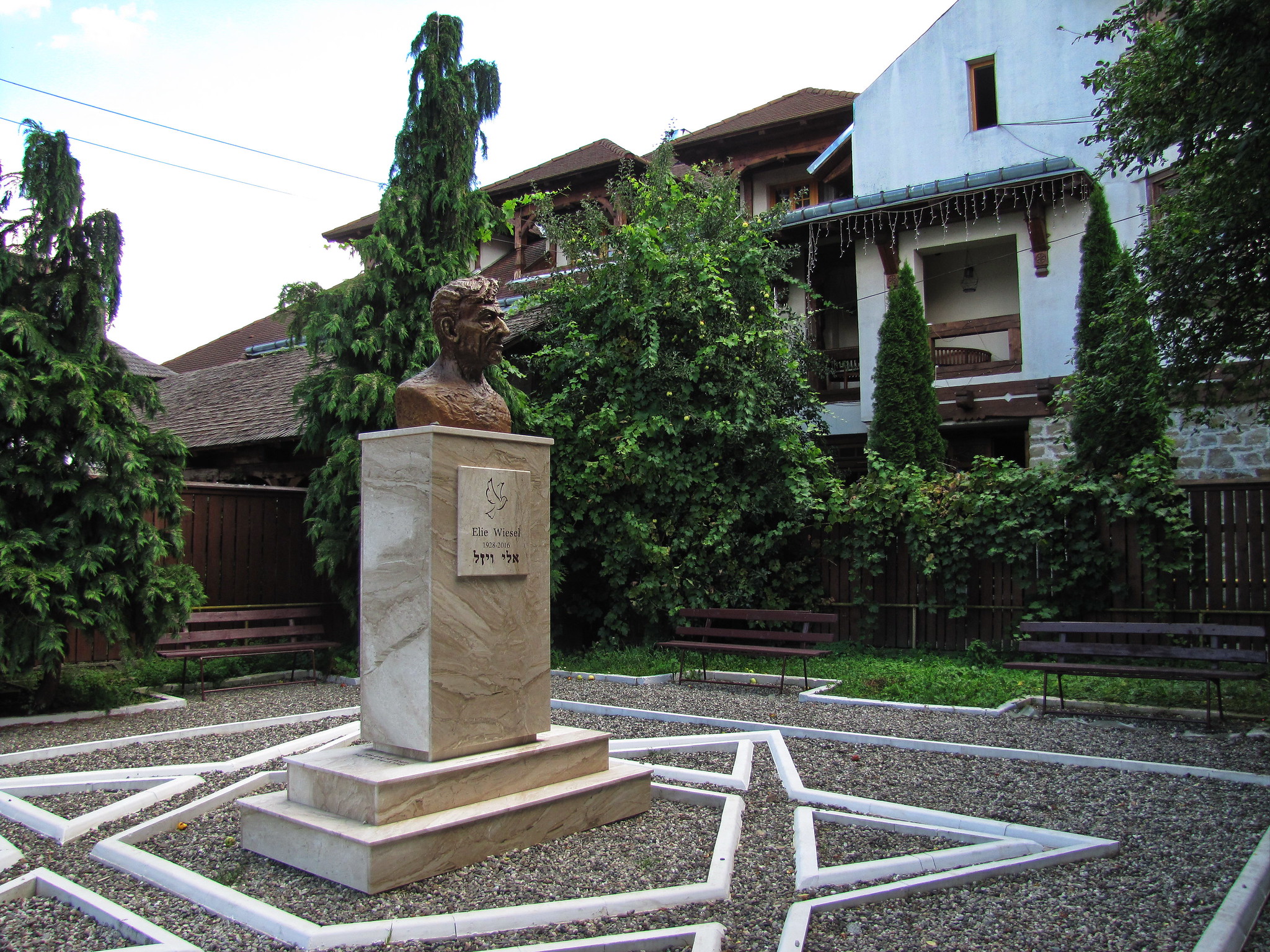
Memorial to Elie Wiesel outside his childhood home in Sighet
Elie Wiesel gave us Sighet - to help us understand, to help us remember. Now the question becomes - are we doing enough to make sure memory lives on?
Recommended for you:
HOLOCAUST AND HATIKVAH
Explore the connection between Holocaust, Hope and Israel in our effort to remember and make meaning out of our history as a people.
About the Author
